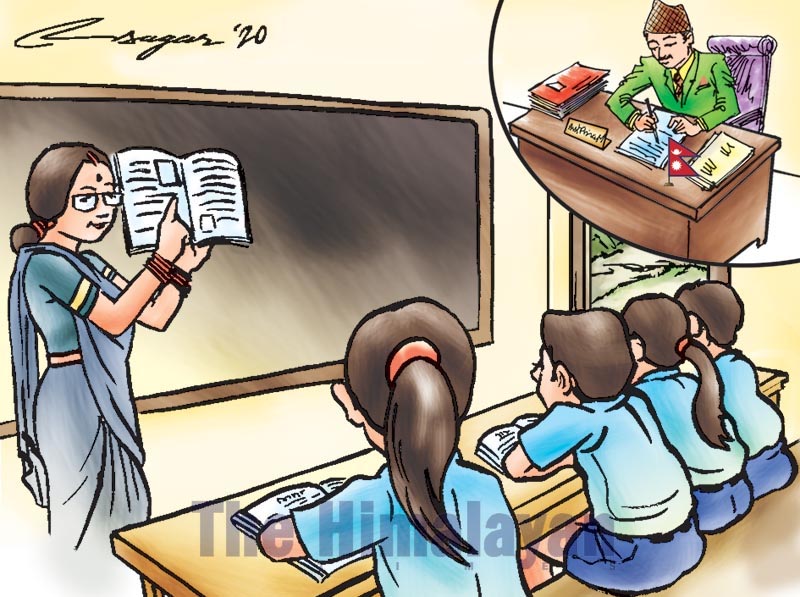Community Learning Centres: An effective tool for development
As CLCs are community-based, community participation is a must to make their activities successful. But there is poor participation of community members in the planning, implementation and management of CLC activities
Community development is part and parcel of national development. Without community development, the goal of national development can hardly be achieved. With this in view, community learning centres (CLCs) were brought into existence in the country in the 1990s. Such CLCs are set up by the Education and Human Development Resources Centre under the Ministry of Education.
In the beginning, the concept of one CLC per constituency emerged followed by the concept of one CLC per municipality and VDC, resulting in the establishment of over 1,000 CLCs at once. Now there are 2,151 CLCs throughout the country.
CLCs are community-based organisations run, managed and monitored by the communities themselves. However, they are often supported, both financially and technically, by governmental and non-governmental agencies. UNESCO has been assisting the CLC programme since 1998. Their activities are designed in such a way as to be compatible with the community context so as to meet the requirements of communities.
Basically, the objective of CLCs is to impart education to children deprived of a formal education, youth and illiterate or semi-literate adults, especially from underprivileged communities. CLCs aim at not only enabling people to read and write only but also to equip them with knowledge and skills so that they can stand on their feet and improve their livelihoods.
The scope of CLCs is broad. Its objectives range beyond the bailiwick of basic and functional literacy, post-literacy education, continuing education and lifelong education and include diverse activities such as early childhood education; communication and social interaction; livelihood skills training and support for income generation; health aspects like HIV/AIDS, maternal health, child mortality, family planning, personal hygiene, sanitation, reproductive health and family nutrition; civic education like leadership, human rights awareness, democratic governance, conflict management and resolution and gender education; and environmental management and conservation.
CLCs are an integral part of communities. For effective outcomes, they should be well-organised, dignified, transparent and participatory. Collaboration, participation, inclusiveness, transparency, equality and coexistence are their cherished principles. They not only are part of non-formal education but can also help communities in other ways. They can help in community development by mobilising local resources, conserving the environment, managing solid waste, providing forums for senior citizens, and conserving and promoting traditional knowledge, language, culture and social customs and mores for posterity, among others.
In the present federal context, CLCs are under the jurisdiction of local bodies. In fact, they are treated as a supporting unit of local bodies. They have approving, monitoring and regulating authority. This has foreshadowed open and alternative education. Here, CLCs can come in handy by running the above programmes for out-of-school youth, women and underprivileged.
Although CLCs are the engine of community development, there are a lot of challenges to overcome to make these organisations effective as in other countries like Bangladesh, Japan and Thailand where such organizations are flourishing well. There is lack of resources - human, financial and material- for the effective management of CLCs. CLCs have to depend on volunteers, who are often underpaid, thus demotivating them to work for the organisations. It is because highly skilled and professional people choose formal educational institutions over CLCs.
There are poor links and coordination between CLCs and development agencies engaged at the local level, which acts as a setback in the effective operation of CLC activities. As CLCs are community-based, community participation is a must to make their activities successful. But there is poor participation of community members in the planning, implementation and management of CLC activities. CLCs are unable to address long-term communal needs. CLCs are often dependent on external funding as they are unable to mobilise resources, both financial and material, internally. There is no well-defined national policy or central agency to guide and coordinate CLCs. Further, some politicians or leaders may use CLCs for their vested interests, thus hindering their proper development.
CLCs are an important component of community development. Those working for such organisations need to be motivated through various incentives, including good pay. CLCs can be used as an effective tool for fulfilling one of the sustainable development goals as they are contributing to SDG No. 4, which includes, inter alia, literacy, education and skills development. The country also aims at graduating from a least developed country to a developing country by 2022. There is no denying the fact that education plays a key role in development. So the government should take effective measures to strengthen CLCs, along with an adequate remuneration package for their instructors or facilitators, so that they can build their capacity and operate and manage their activities more effectively and their role in community development can be further amplified.






